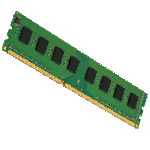WHAT IS MEMORY?
Memory should be seen as more of a separate thing from storage. While storage is permanent and writable, memory is usually nonwritable or nonpermanent. It is a quick way for the processor to access information without firing up a disk or flash memory and waiting forever. ROM, RAM, and CMOS are good examples of Memory.
ROM
"Computers can read data stored in ROM, but can't write new data to it."
- ROM isn't spoken of too much but it is still present on a computer, usually.
- ROM -> "Read Only Memory"
- ROM is usually a chip that has the data flashed into it permanently for the cpu to access whenever, wherever, however.
- An example of ROM is your computer's BIOS boot system, telling it exactly *how* to boot.
RAM
"With RAM, computers can read from and write to that memory."
- RAM is usually what you think of when you hear "memory".
- It contains information that the processor can access far quicker than any disk could.
- However, RAM is volatile, meaning it forgets everything once it loses power.
CMOS
"Computers have a small battery inside them that's always on, even when you power down the rest of the computer."
- CMOS batteries power a piece of volatile memory that holds information like the clock, settings, etc.
- This is information that is memorized to the hardware level but is editable so it needs to be retained.
- Without this little battery, the settings would be restored to default every boot. That's annoying!



